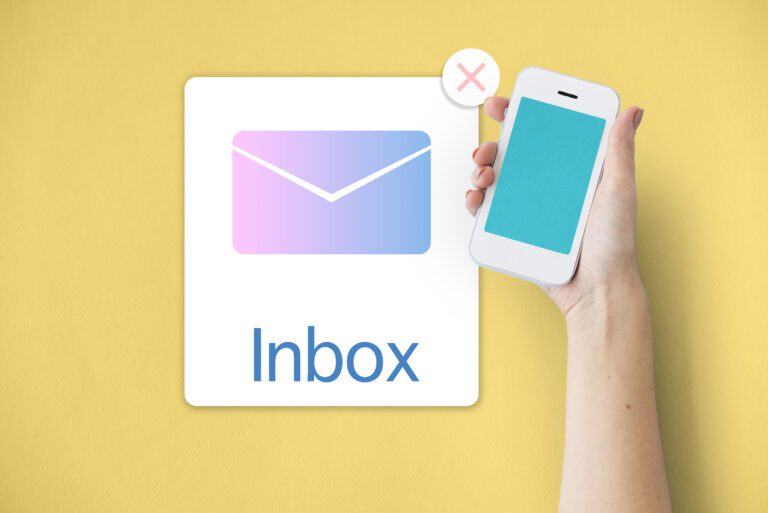Email Collection: 17 Best Practices to Exponentially Grow Your Email List

I hope you enjoy this blog post. If you want Hello Bar to grow your leads, click here.
Author:
Ryan Bettencourt
Published
August 5, 2024
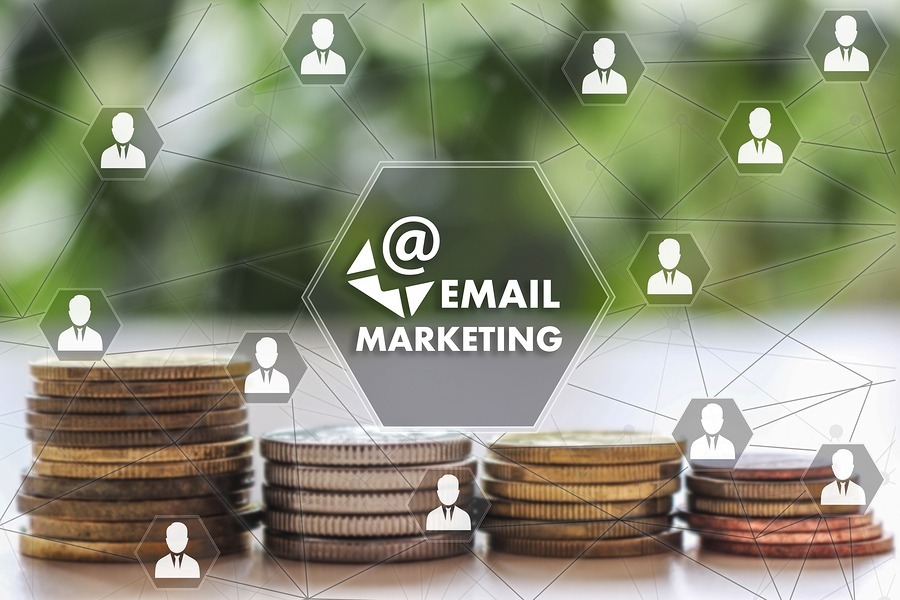
Email collection is a bit like dating. You might like someone, but you need their phone number, email address, or other contact information to create a relationship.
Email marketing is no different from personal relationships; you’re not an email marketer unless you have subscribers, so email collection has to come first. Similarly, you’re not in a relationship if you don’t contact prospective partners.
Over time, you’ll scrub your email list to eliminate inactive subscribers, just as you might break up with many people before you find The One. That sounds painful — and it can be — but forming the right relationships is necessary.
We hope you don’t break up with boyfriends or girlfriends that often, but you get the picture.
Since you’ll scrub your list and people will unsubscribe, you need to prioritize email collection in your marketing campaign. Over time, you’ll identify the strategies and best practices that work for your business. For now, you’ll follow some basic best practices.
We’ll share a few insights into email marketing to help you start email collection right away.
What Is Email Marketing?
At its most basic, email marketing is the process of converting website visitors into leads and leads into customers. It’s like the dating ritual. You attract potential partners, convince them you’re worth their time, and eventually form a committed bond.
With email marketing, though, the end results in a sale instead of a ring..
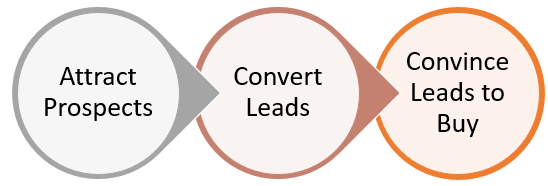
Sounds easy, right? But here’s the kicker: You need many prospects because you can’t convince everyone to join your email list.
That’s why email collection becomes the most important part of the process. Sure, you want your leads to buy your products or services, but every relationship — even in business — has to start somewhere.
So, where do these prospects come from? They might click over to your latest blog post from social media or hear about your product from a friend. Perhaps they stumble across your content during a Google search.
There are many places to attract prospects, but you have to get them to convert.
Why Is Collecting Emails Important?
Email collection is super important for your business because it helps you stay in touch with people interested in your offerings. In fact, a recent report shows that 63% of business marketers are increasing their email activity for this purpose.
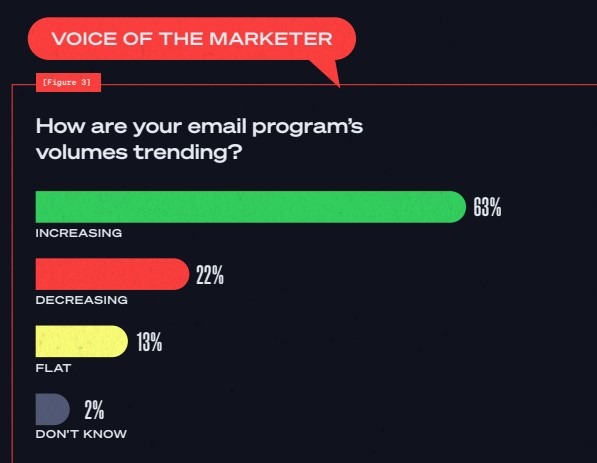
Image via Validity
Even small businesses are on the email marketing wagon, with 64.1% of them using it to connect with their customers. For e-commerce businesses, every $1 spent on email marketing can bring back up to $36 more than paid ads and SEO combined.
Here’s why collecting email addresses should be on your to-do list:
- Reach Your Target Audience: People who sign up for your email list are interested in your offerings, making it easier to connect with potential customers.
- Build Meaningful Connections: Sharing valuable content and updates in your email marketing campaigns helps you build strong relationships with your audience.
- Promote Exclusive Offers: Share special deals, exclusive discounts, and early access to new products with your email subscribers to make them feel valued and special.
- Drive Website Traffic: Sending emails with links to your website can bring more visitors, boosting your web presence and potential sales.
- Gather Actionable Insights: Tracking how people respond to your emails tells you what works and what doesn’t, helping you improve your marketing strategy.
Remember, the more email addresses you collect, the more chances you have to turn potential customers into loyal ones. So, keep working on your email collection efforts!
You May Also Like:
- How to Build an Email List From Scratch: Start-to-Finish Guide
- How to Grow Your Email List: 21 Great Tips for 2024
How Do I Collect Email Addresses on My Website?
To collect email addresses, you need one or more forms on your website where interested consumers can sign up for your email campaign. For instance, the lifestyle blog Apartment Therapy uses an exit popup to invite people to subscribe to their daily emails.
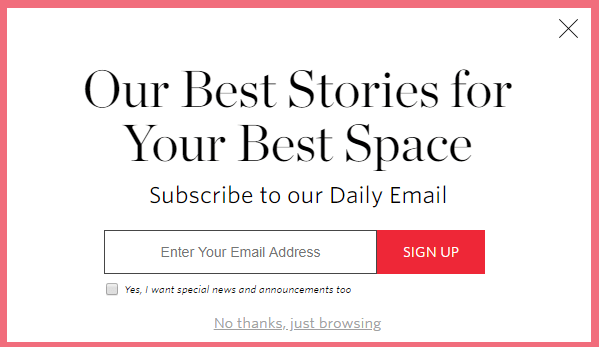
You can recreate a similar exit popup via Hello Bar.
Adding a top bar can add more diversity to your email collection campaign. Just sign into Hello Bar, choose the email collection goal, and type in what you want your top bar to say.
![]()
The bar will appear at the top of your site to remind visitors they can sign up. You can animate your top bar, change the colors, and even A/B test the headline and call to action (CTA).
Other places to include a form or CTA to sign up for your mailing list include:
- At the end of your blog posts
- In the middle of your blog posts
- In the sidebar of your website
- In the footer
17 Email Collection Best Practices to Constantly Grow Your Email List
Without further ado, let’s get into the good stuff. Email collection is like wooing a potential romantic partner, so that’s how you should approach it. You don’t want to talk too much about yourself, make promises you can’t keep, or leave the other party with the impression you have nothing to offer.
So, what are the email collection best practices? We’ll check out 17 tips and strategies that have worked for me over the years.
1. Create an Amazing Lead Magnet
It’s okay to get creative with lead magnets. Think of them as pickup lines — they work best when they surprise and delight the person you’re trying to woo.
Instead of the traditional ebook or whitepaper, you might create a fantastic toolkit that helps prospective customers solve a serious problem. In other words, your email content needs to provide value from the start.
Don’t worry about giving away too much. That’s much better than giving away too little.
Once you’ve created your lead magnet, let your website visitors know about it. For example, create a top bar from your Hello Bar account so everyone knows they can get a copy of your lead magnet.

The link can take your visitor to your lead capture page so you can close the deal.
You May Also Like:
- 19 Abandoned Cart Email Best Practices to Boost Conversions
- Ecommerce Email Marketing – 25 Tips to Increase Sales
2. Constantly Offer Your Email Subscribers Valuable Content to Spark Referrals
Did you know that your email subscribers can do some of the heavy lifting when it comes to email collection?
It’s similar to meeting someone you know your best friend would be interested in at work. You don’t keep it to yourself; you make the introduction.
Word of mouth works great when you consistently offer your email subscribers valuable content. They’ll want to share it with their friends, so they’ll forward your emails.
Ensure you include a subscribe call to action button in all your marketing emails. That way, when the recipients forward your emails, those prospects can sign up for your list.
3. Promote Your Email Newsletter Signup Form on Different Areas of Your Website
If you view your Google Analytics reports, you’ll notice that visitors arrive at different places on your site. They might find you through Google searches, social media posts, or other ways.
Soulmates meet in the strangest of places. The opportunity might pass you by if you’re not ready for that meeting. The same goes for a website page that doesn’t contain a palatable offer.
Your user flow report can also be useful in Google Analytics. Figure out where people go after visiting your site for the first time so you can present the right offer at the right time.
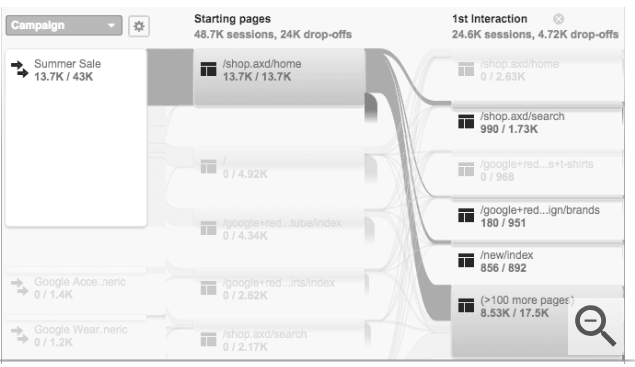
The first interaction matters, whether you’re launching an email collection campaign or looking for a lifelong partner. But other interactions matter, too.
4. Divide Your Email List Into Segments
Segmenting your email list helps you send the right messages to consumers based on where they fall in the conversion funnel.
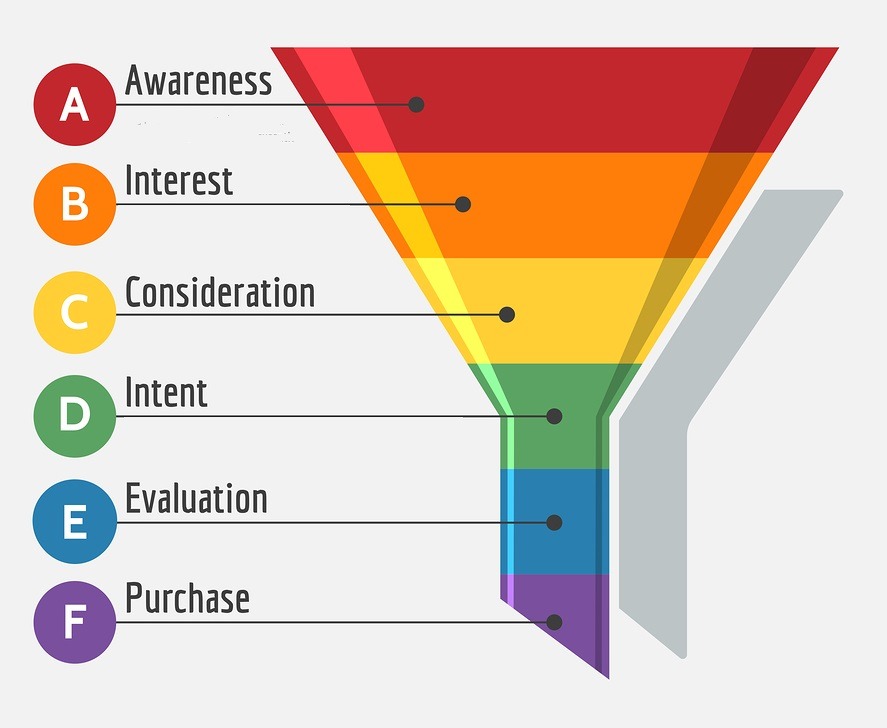
For instance, a coupon code might benefit consumers who are ready to purchase your product or service. In contrast, those in the evaluation stage might benefit from a comparison chart of different products or services they might benefit from.
Keep timing in mind when collecting emails. You wouldn’t propose on the first date, right? But if you’ve been dating casually for 15 years, you might need to rethink your strategy.
5. Create Amazing Popups With Hello Bar to Promote Your Newsletter
Popups work great when used correctly. It’s like bringing flowers on the first date. Corny? Sure. Overdone? Of course. But it still works.
Use Hello Bar to create an exit popup. It only appears when your visitor tries to click away.
Ensure it’s attention-grabbing and eye-catching. More importantly, provide an offer your audience can’t refuse.
6. Make It Extremely Simple to Sign Up for Your Email List
Have you ever had one of those dates during which the other person seems to interrogate you like a murder suspect?
You might have a similar feeling when you’re confronted with a signup form like this one:
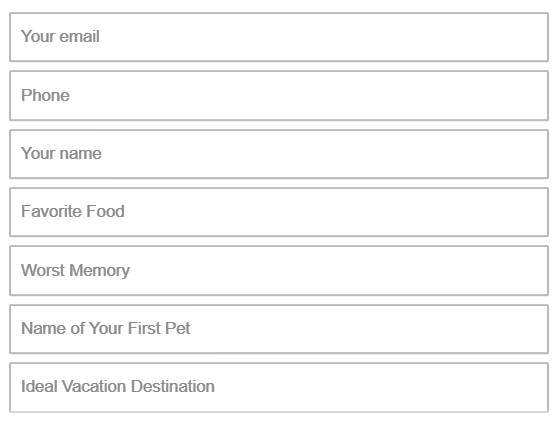
Who has time for all that? If you ask for too much information — and yes, we exercised a little hyperbole here — your prospects will ask for the check before you even get your appetizers.
You May Also Like:
- 17 Great Welcome Email Examples to Inspire Your Campaign
- Opt-In Email Marketing: 13 Best Practices To Better Results
7. Offer Upgrades and Discounts for Customers Who Sign Up
Incentive is the most important word we want you to take away from this article. Memorize it. Write it on a Post-It and stick the message on your computer monitor. Whatever.
You have to incentivize people to sign up for your newsletter. Email collection is all about a transaction. You want people to sign up for your email list, but what will you do for them?
Check out this top bar:
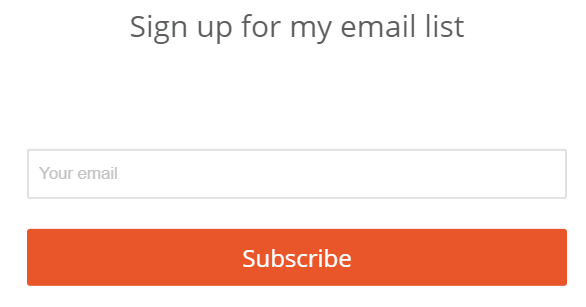
Not very compelling, right? But we can jazz it up to make you want to opt in:
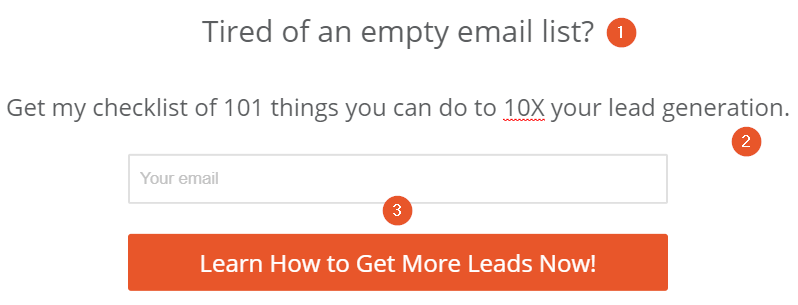
That’s better.
- Picking at a pain point and establishing rapport with the prospect
- Offering a way to resolve the pain point for free using a compelling number
- Adding a CTA that reflects the offer
8. Use Social Media to Promote Your Website and Your Lead Magnet
Social media is great because it allows you to cross-pollinate your followers. If someone follows you on Twitter, you can invite them to join your email list with a well-thought-out lead magnet. Similarly, if someone visits your website, you can use Hello Bar to invite them to Tweet about your content.

It’s important to use your existing followers, regardless of where they are.
9. Host Giveaways to Collect More Emails
Who doesn’t like a freebie? Giveaways serve three important purposes:
Use a Hello Bar alert to inform people about your giveaway. They can click the link to learn the details about how to enter.
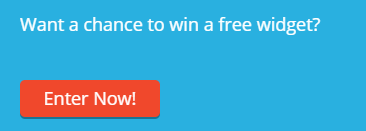
The price to enter? The prospect’s email address.
Don’t forget to advertise your giveaway far and wide. They perform particularly well on social, so get your Instagram, Twitter (now X), and Facebook followers in the mix.
10. Use Paid Ads to Promote Your Lead Magnet
Sometimes, you have to put up a little cash to get what you want.
Not getting dates at bars and nightclubs? Sign up for Match.com. It’ll cost you a few bucks, but it hastens the process.
The same goes for paid ads, whether you post them through search or social. Use the same strategies we’ve already discussed, such as including a compelling image, headline, and CTA. You’ll get more email signups that way, and email collection will become much faster.
Start with a small budget, then work your way up. You don’t have to spend every dollar in the bank to get great ROI from paid ads.
You May Also Like:
- Email List Cleaning: Clean Your List Without Losing Conversions
- Email Copywriting: 19 Proven Formulas to Use on Your Next Campaign
11. Use a CTA Button on Your Facebook Business Page
You might have seen one of these buttons on Facebook Business Pages:
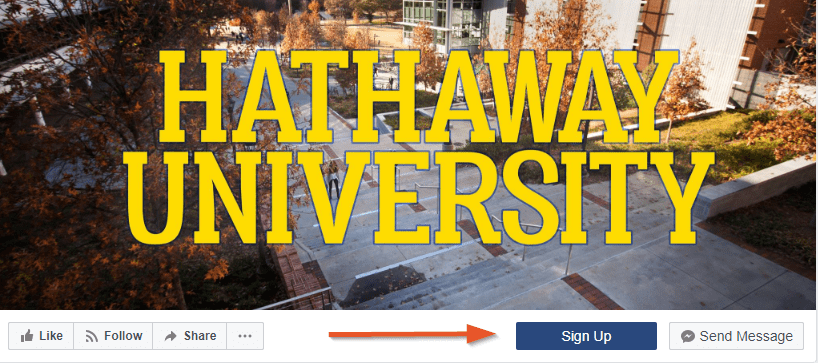
It’s just a regular old CTA that lets your Facebook page visitors sign up for your email list right from Facebook.
It’s a way to reduce friction. If your followers go through too many steps to sign up, they won’t bother. Why would they when they can scroll for memes instead?
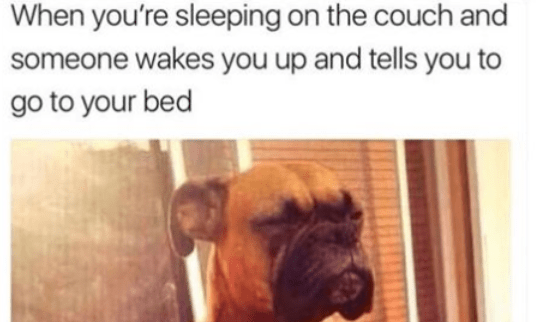
If you don’t have a Facebook Business Page, create one right now. You’re leaving money on the table without one because millions of people spend time on Facebook daily.
12. Increase Email Collection by Attending Networking Events
Going to networking events might sound like the greatest plan in the world or the worst one, depending on your personality type. However, don’t discount the value of meeting people in person and inviting them to sign up for your email list.
For one thing, it’s harder to say “no” in person. You don’t want to put someone on the spot, but you can casually say, “Hey, I send out free coupons once a month. Would you like to get them, too?”
The other person can either agree or decline; either way, you’ve planted the seed.
Again, make the process as easy as possible. Pull up your website on your phone, navigate to your signup form, and invite the person to enter their details.
Another option is to hand out business cards with your website address. Mention your email list on the business card design so people can decide whether or not to follow up. You can also use a QR code generator to create a QR code that encapsulates your website’s URL to effortlessly bring them directly to your site.
Remember that reciprocity is powerful. If the other person has an email list, offer to sign up for it.
13. Include a Link To Your Newsletter Signup Form in Your Email Signature
Sometimes email collection boils down to the simplest of activities. Adding a link to your newsletter signup page in your email signature can boost conversions significantly.
Ensure it attracts attention so people don’t think it’s a typical signature. For instance, use a catchy phrase or sentence and link to it in your brand’s primary color.
Include that same signature in the emails you send to your subscribers. If they forward the email to friends, family members, or colleagues, those people will know how to sign up for themselves.
14. Host Events and Ask Attendees to Join Your Email List
Have you ever hosted a live webinar? It’s fun and a great chance to attract new leads to your email list.
A live webinar allows you to communicate with your prospects live. It doesn’t take expensive equipment or excellent oratory skills. Just talk to your audience like you’d talk to friends.
At the end of the webinar, tell people exactly how they can sign up for your list.
Other events, such as going live on Facebook or Instagram, offer new opportunities for email collection. Think outside your website when you’re trying to build a solid email list.
You May Also Like:
- How to Build an Email List From Scratch: Start-to-Finish Guide
- How to Grow Your Email List: 21 Great Tips for 2024
15. Constantly A/B Test Your Sign-Up Forms
A/B tests form the cornerstone of email collection. Test different versions of your headline and call to action to get maximum signups.
For instance, you might A/B test the wording in your CTA.
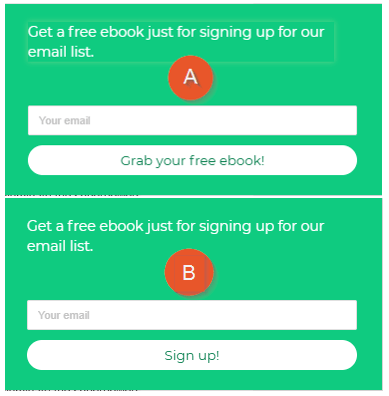
A/B test the colors you use, the type of Hello Bar style, the headline, and anything else that might make a difference in conversions. That way, you know you’re sending the right message to the right consumers.
Don’t stop after just one test. Maybe you’ll come up with an even better CTA or headline. Test it against the reigning winner to see how it performs. Hello Bar allows you to automatically A/B test different models. It also gives you the statistically significant “winner,” so you don’t have to comb through mountains of data.
16. Create Email Drip Campaigns to Engage All Your New Email List Subscribers
Email collection isn’t the end of the story. After you’ve collected emails from your target audience, you need to engage them with content.
Think of this as your second date. If you’re no longer charming, funny, witty, warm, or kind, your date will likely decline a third.
Email drip campaigns set you up for success from the very beginning. You have a series of emails you want to send to new subscribers regularly, such as once a week. After that series, you can “graduate” your subscribers to a new drip campaign that nurtures them through the funnel.
Automating your email drip campaigns makes them even more indispensable. After all, you have more to do for your business than write emails all day.
17. Optimize Your Signup Forms for Mobile Users
Optimizing your signup forms for mobile users is key for effective email collection.
Did you know that around 96.3% of global users access the internet via mobile phones, and 94% do so via smartphones? That’s a huge audience!
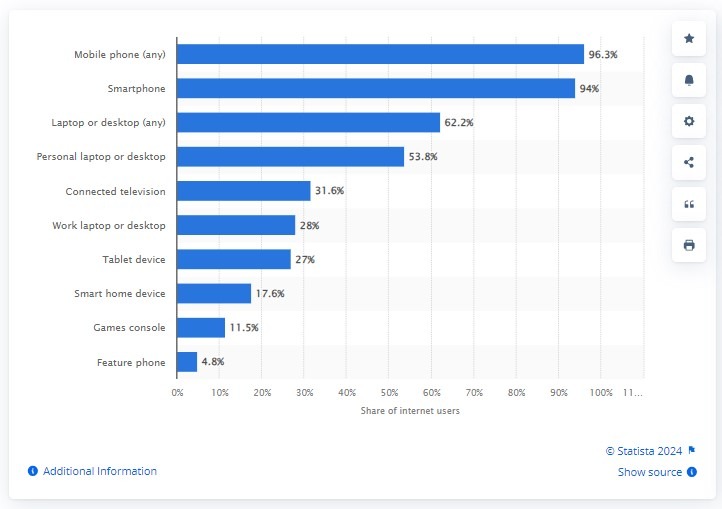
Image via Statista
If your forms are mobile-friendly, people will easily sign up for your email list on the go. A smooth mobile experience makes it a breeze for users to join your email list, boosting conversion rates.
Just ensure your forms load fast and are easy to use.
You May Also Like:
- How to Get Facebook Followers and Greatly Increase Your Social Presence
- 5 Ways To Determine Which Social Media Platform Is The Best For Your Business
Collecting Emails From Different Visitors
The average website conversion rate across all industries is 2.6% and 2.5-3% for ecommerce businesses. With email collection strategies, you can collect emails from various website visitors to grow your email list and boost conversions.
Here’s how:
Social Media Followers
Social media followers come to your site from your social media accounts. You can collect their email addresses using:
- Social media posts with links to signup forms
- Exclusive content offers in exchange for their email
- Contests and giveaways
Email collection from them helps you engage with them more deeply and turn them into loyal customers.
Event Attendees
Event attendees are website visitors who visit your site for a specific event, like a webinar or a sale. Collecting their email lets you keep them informed about future events and offers.
Consider using:
- Event registration forms
- Follow-up emails
- Exclusive content like event recordings
- Surveys and feedback forms
Referral Visitors
Referral visitors come to your website because another website, peers, or influencer recommended you. When your existing subscribers or customers refer a friend through email or popup, those people get a special email to subscribe with a discount code.
Use:
- Guest post links
- Influencer promotions
- Referral program signups
- Special landing pages
Email collection from referral visitors is important because they already trust the recommendation and are a step away from becoming loyal customers.
Window Shoppers
Window shoppers are first-time visitors who browse your website without buying anything. Capturing their emails lets you keep in touch and encourage them to return and make a purchase.
Consider using:
- Opt-in popups
- Onsite notification
Deal Hunters
Deal hunters are website visitors looking for the best bargains. They might visit your site after clicking ads or checking other stores.
You can use:
- Discount popups
- Spin-to-win wheel campaigns
- Personalized landing pages with special deals
- Back-in-stock updates
- Product giveaways
Getting deal hunters’ emails helps you send them special offers and turn them into customers.
Best Tools for Collecting Email Addresses
Email collection tools help you gather email addresses from your website or social media. According to the previously quoted Statista report, 58% of businesses use these tools with automation because they make up to 30X more revenue per person than regular email campaigns.
To help you enjoy these benefits, here are five top email collector tools you can use:
Hello Bar
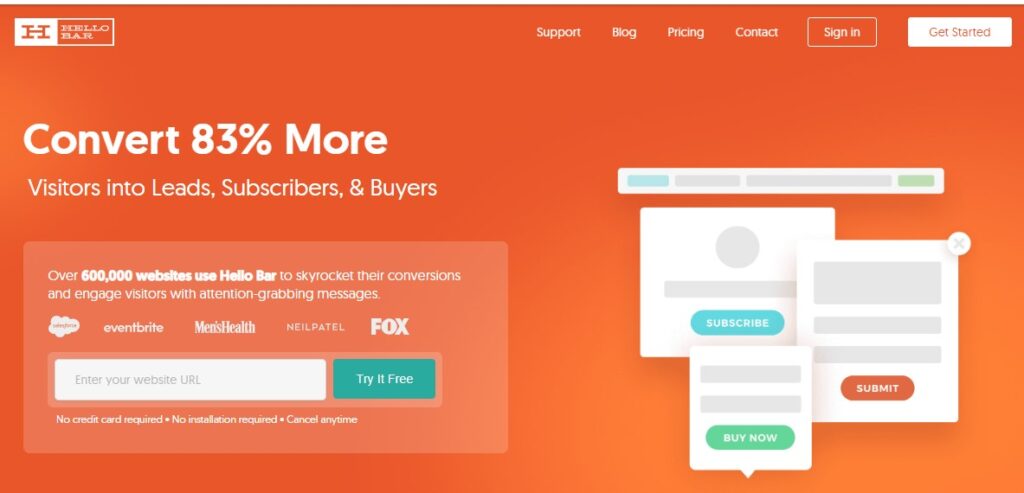
Image via Hello Bar
The list begins with our very own Hello Bar. This tool lets you add attention-grabbing pop-ups and bars to your website to capture email addresses. It’s simple to use, and you can easily integrate it into WordPress websites to enhance your web presence.
Hello Bar helps you collect email addresses by offering exclusive discounts and engaging users with interactive elements. It’s great for capturing leads and expanding your email database.
Sleeknote
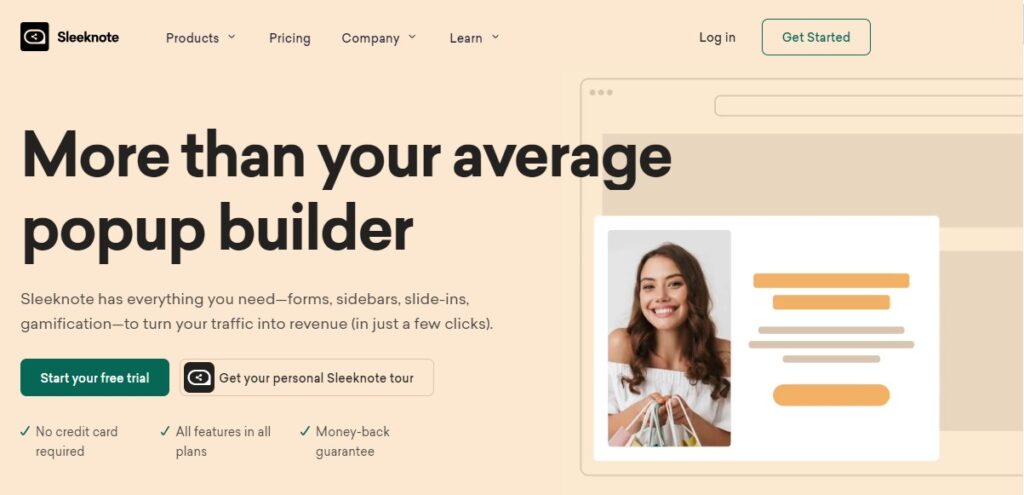
Image via Sleeknote
Sleeknote is a fantastic tool for email collection. It lets you add pop-ups, forms, and slide-ins to your website to capture email addresses. You can also create custom designs that match your brand and even offer giveaways and discounts to get more subscribers.
Plus, you can choose when and where these pop-ups show up to ensure they work best. Pricing starts at $69/month, and you can try it free for 14 days.
OptinMonster
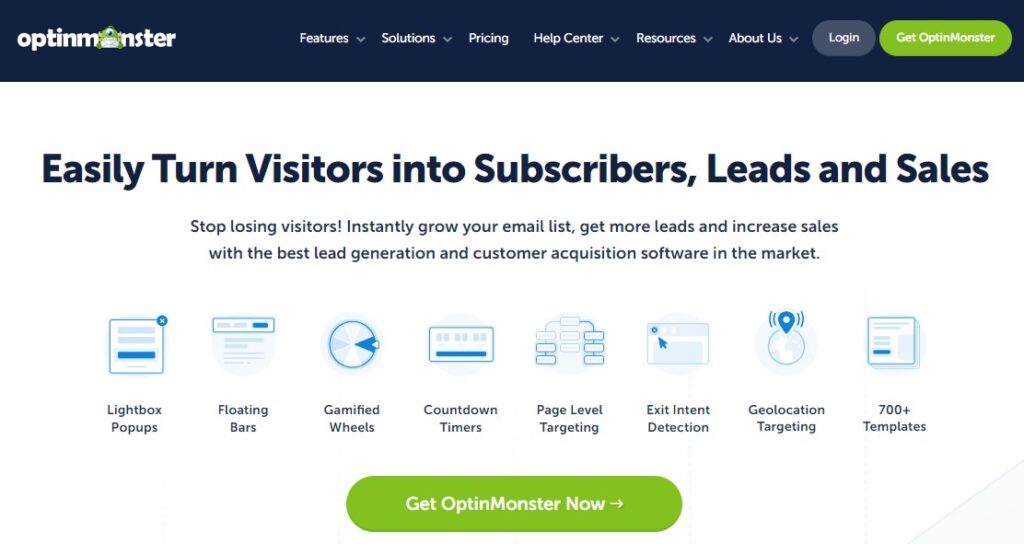
Image via OptinMonster
OptinMonster is a popular tool that helps with email collection. It uses opt-in forms, popups, and other tools to capture email addresses and convert website visitors into subscribers.
With its simple interface, you can easily create engaging opt-in forms using drag-and-drop or ready-made templates.
OptinMonster also helps you understand visitor behavior and improve your conversion rates. Paid plans start at $29.99/month.
Hunter.io
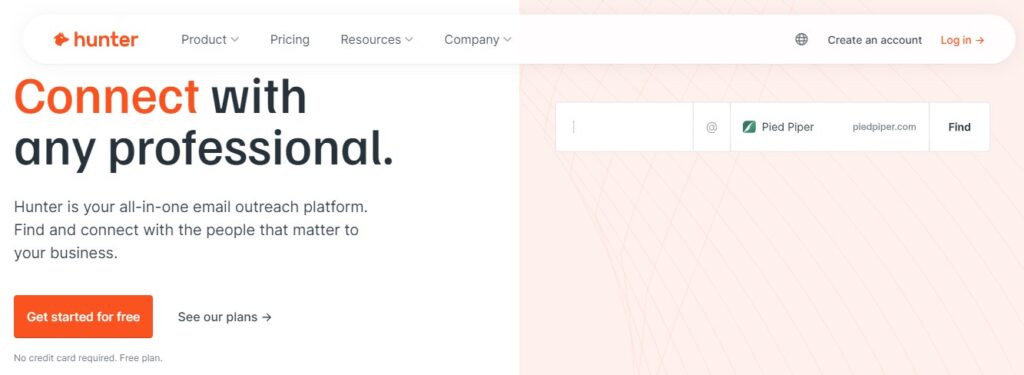
Image via Hunter.io
Hunter.io is an email collection tool that helps you find email addresses quickly. Simply enter a company’s domain or a person’s name and company to get their emails.
It also lets you upload a CSV file to extract lots of emails simultaneously. The tool includes features like an Email Verifier and a follow-up system.
Hunter.io offers a free plan for 25 email searches a month, with paid plans starting at $49/month.
UpLead
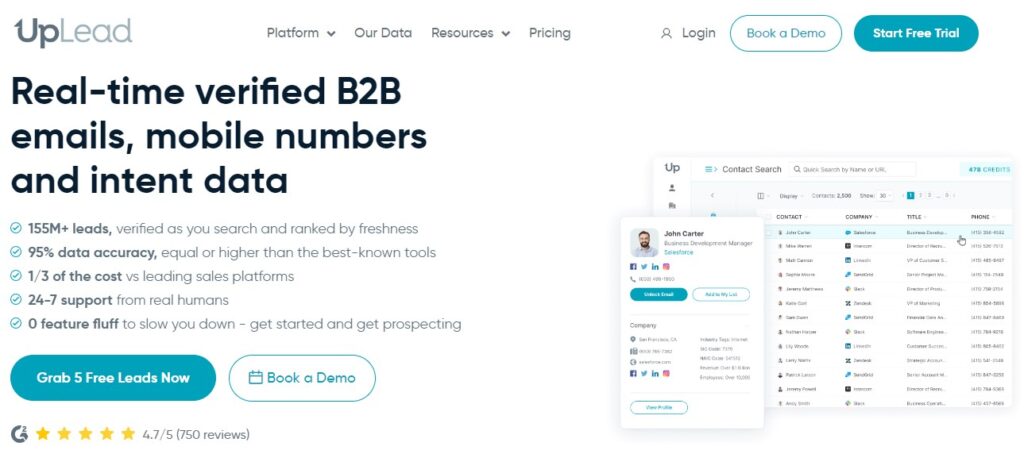
Image via UpLead
UpLead provides real-time verified B2B emails and mobile numbers that enable email collection. It offers a huge database of 155 million leads with 95% data accuracy.
You can use 50+ search filters to find the right contacts and get their email and phone numbers. UpLead also has a Chrome Extension to capture leads while you browse the web.
They offer a free 7-day trial with five credits.
5 Effective Email Collection Tactics with Examples
Now that you know the various website visitors to collect email addresses from and tools to use, let’s see how it actually happens. Here are some notable examples of email collection at work:
Event Registration Forms
Usually, about 30% -50% of people who sign up for webinars attend. The average conversion rate for webinars stands at 55%!
Event registration forms are great for signing up event attendees for virtual events. The forms collect the attendees’ contacts, including email addresses to register. You can later send them updates and information about future events.
Beau Eckstein’s free webinar registration form is an excellent example of lead generation. It promises valuable content while requiring email addresses for signups.
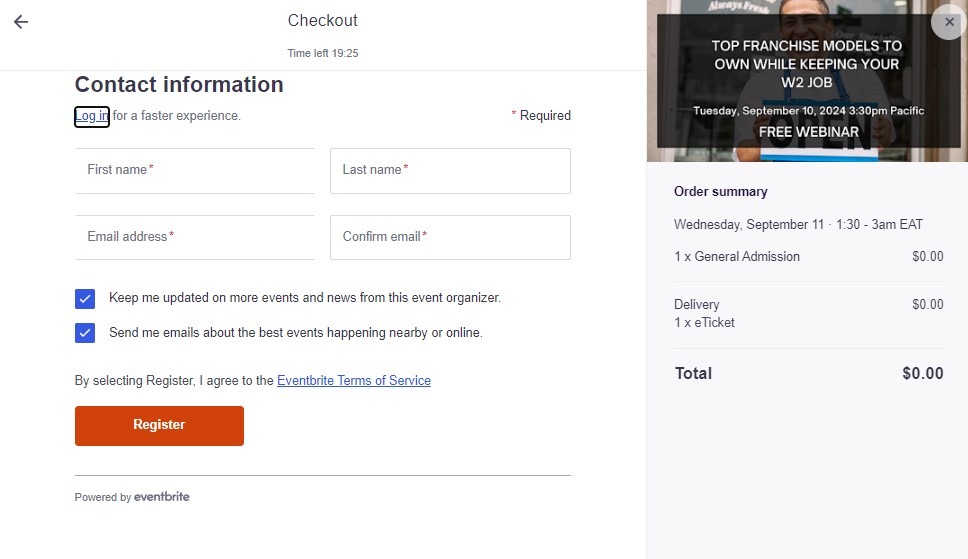
Image via Eventbrite
Lead Magnet
A lead magnet is something valuable you give away for free in exchange for an email address. It could be an ebook, a guide, or a free sample.
People love getting useful stuff, so this is a great way to get their email addresses.
HubSpot’s free Email Marketing Planning Template download form is an excellent example of a lead magnet. It’s simple: offering a valuable resource in exchange for just an email address.
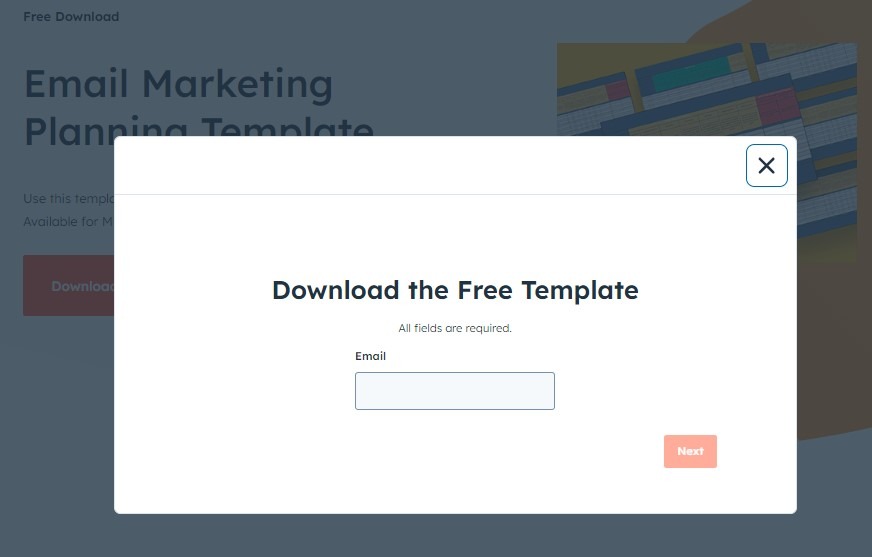
Image via HubSpot
Spin-to-Win Wheels
Website visitors love the excitement of potentially winning something. One way to give them that is through spin-to-win wheels. It’s an interactive and engaging method to boost your email collection efforts.
These wheels are like fun games where visitors spin to win prizes. However, to play, they have to enter their email addresses first, a strategy Isabella Grace Jewellery has executed perfectly!
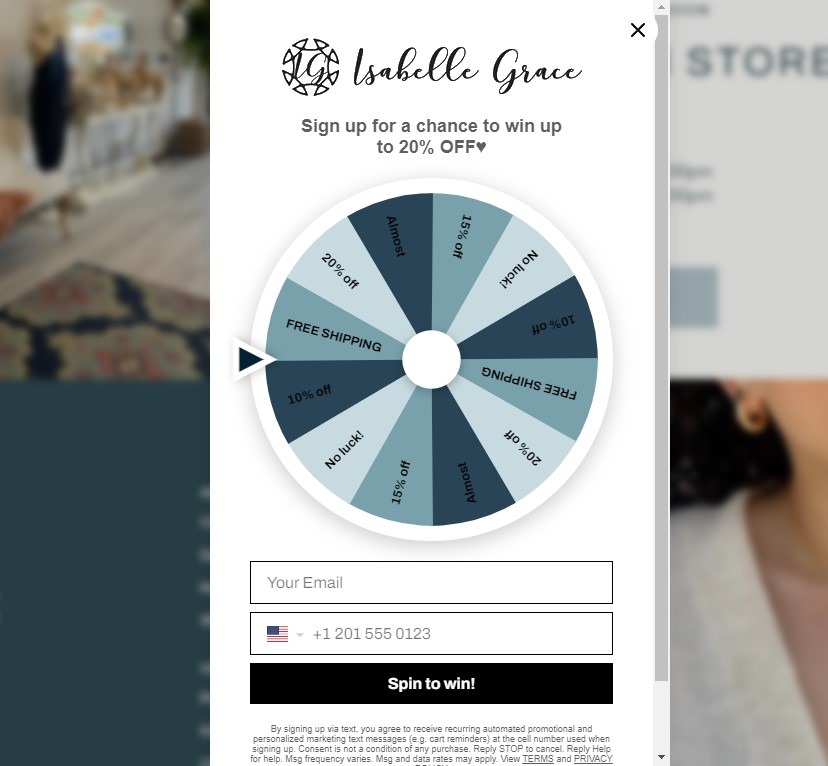
Image via Isabella Grace
Product Giveaways
People love free goodies. We know we do! Product giveaways are great for email collection because everyone wants a chance to win something cool.
People share their email addresses when they enter the giveaway. It’s an easy and fun way to build your email list and connect with new customers.
Jysk Vin leveraged this strategy website visitors can win several bottles of wine after signing up for their newsletter.
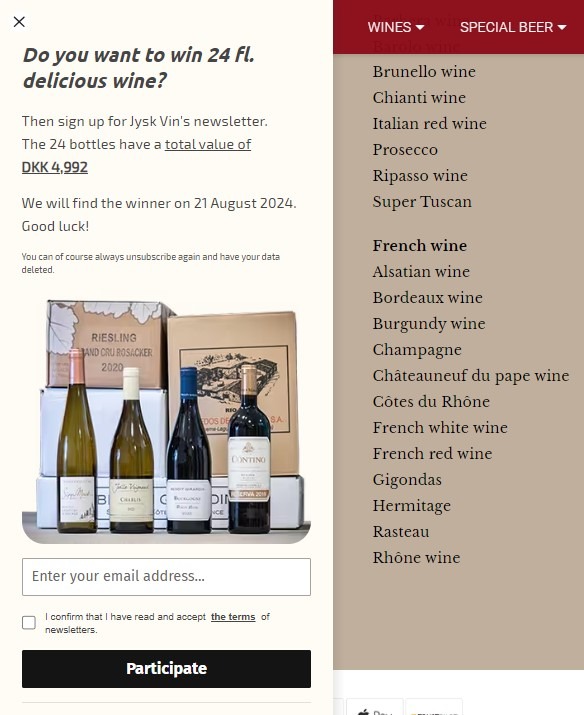
Image via Jysk Vin
Opt-In Popups
Opt-in popups are like those friendly little nudges on websites that say, “Hey, want something cool?” They’re perfect for email collection because they offer discounts or special deals in exchange for your email address. It’s like a virtual high-five for your inbox!
These popups can catch people’s attention immediately when they visit or are about to leave your website, turning them into happy subscribers. And that’s exactly what Boll and Branch have done.
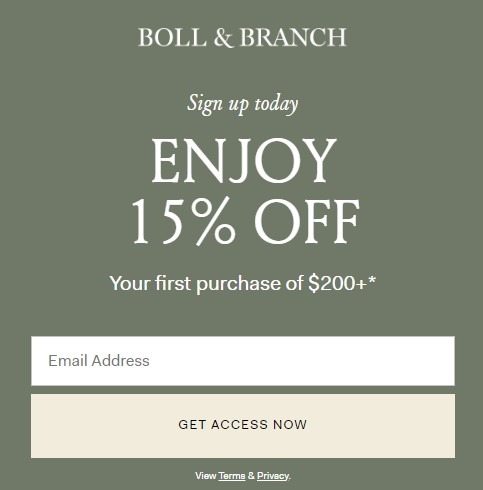
Image via Boll & Branch
You May Also Like:
- 23 Email Marketing Statistics To Highly Increase Your Conversions
- Converting Marketing Leads into Sales Leads: 7 Expert Tips
FAQs
Q1. What are the most attractive incentives for email sign-ups?
Lead magnets, like exclusive discounts or valuable content, ebooks, reports, sample products, webinar reservations, and more entice website visitors to fill out opt-in forms or sign-up forms. Offering something valuable helps to capture email addresses and build your email database.
Q2. How can social media be leveraged to grow your email list?
You can share links to landing pages or opt-in forms on your social media accounts to collect email addresses. Encourage followers to sign up for exclusive content or deals and use pop-ups on social platforms to capture emails.
Q3. What role does content marketing play in email list growth?
Content marketing attracts website visitors with valuable content, encouraging them to fill out opt-in forms or pop-ups. This turns engaged readers into email subscribers.
Q4. How can landing pages be optimized for maximum email collection?
Ensure landing pages have clear headlines, user-friendly interfaces, and visible opt-in forms. Use interactive elements and page-level targeting to engage visitors and capture email addresses with just a few clicks.
Q5. How can I build a healthy email list?
To create a healthy email list:
- Give something valuable.
- Use popups to grab visitors’ attention and ask for their emails.
- Promote on social media platforms.
- Create great content.
- Run contests or giveaways.
Conclusion
Email collection is a lot like dating. Sometimes, you get a phone number during your first encounter, and sometimes, you have to see each other around town a few times before connecting.
However, you can hasten the process by setting yourself up for success.
If you’re dating, you wear your best clothes, offer a pleasant smile, and behave like a decent human being.
If you’re collecting emails, offer a valuable lead magnet to incentivize the prospect and as many people as possible.
Here’s a handy checklist you can copy and paste if you want to refer to it often. They’re our best practices for email collection:
- Create a lead magnet
- Constantly offer amazing content to subscribers
- Promote your newsletter on every page
- Segment your email list
- Create awesome popups
- Simplify the signup process
- Offer upgrades and discounts
- Use social media to attract subscribers
- Host giveaways
- Take out paid ads
- Add a CTA button to your Facebook Business Page
- Attend networking events
- Link to your signup form in your email signature
- A/B test signup forms
- Host events
- Incentivize referrals
- Create email drip campaigns
Now that you’re armed with all this useful knowledge, go forth and collect emails.
What’s your best strategy for collecting emails?



